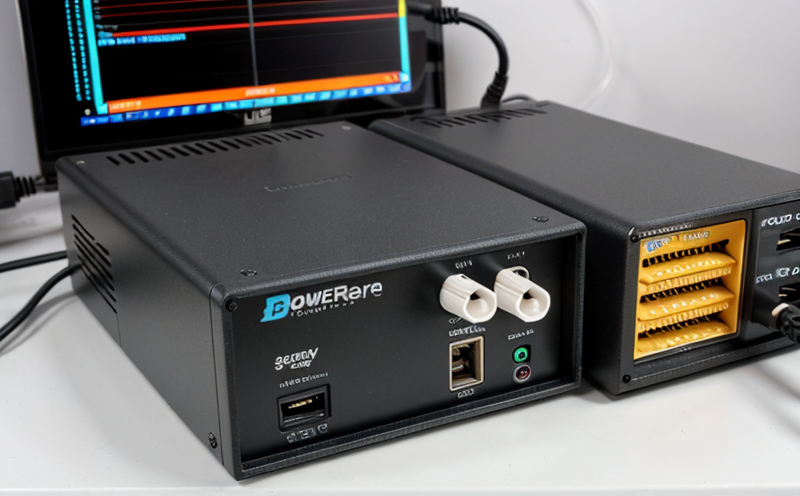ETSI ES 202 336 Power Efficiency Testing for ICT Power Units
The ETSI (European Telecommunications Standards Institute) standard EN 302 712 V1.4.1, commonly known as ETSI ES 202 336, is a critical document in the realm of ICT power units testing. This standard specifies methods for determining the power efficiency and energy consumption characteristics of ICT equipment, which includes power supplies and chargers used in information technology infrastructure.
ICT power units are essential components that ensure reliable operation of IT equipment by providing stable voltage and current levels. However, they also consume a significant amount of electricity, often contributing to high operational costs and environmental impact if not optimized for efficiency. ETSI ES 202 336 aims to address these challenges by ensuring that ICT power units meet stringent energy efficiency requirements.
The standard focuses on the following key aspects:
- Measurement of input and output power
- Determination of no-load, half-load, and full-load efficiencies
- Evaluation of thermal behavior under various conditions
- Assessment of harmonic distortion levels
- Compliance with international standards such as IEC 61000-4-30 for EMC (Electromagnetic Compatibility)
Compliance with ETSI ES 202 336 is crucial for manufacturers aiming to meet regulatory requirements and improve the energy efficiency of their products. By adhering to this standard, companies not only enhance product performance but also contribute positively to environmental sustainability.
The testing process involves several steps including:
- Instrumentation setup: Calibration of measurement instruments according to IEC 61000-4-30
- Power supply and charger configuration: Ensuring the device under test (DUT) operates in different load conditions (no-load, half-load, full-load)
- Data acquisition: Continuous monitoring of power consumption and efficiency metrics during various operational scenarios
- Analysis and reporting: Generation of detailed reports highlighting compliance with specified thresholds
Failure to comply with ETSI ES 202 336 can result in product recalls, fines, and reputational damage. Therefore, thorough testing is essential for ensuring product quality and market readiness.
Scope and Methodology
| Parameter | Description |
|---|---|
| No-load Efficiency (%) | The efficiency of the ICT power unit when no load is applied. |
| Half-load Efficiency (%) | The efficiency at 50% of rated output power. |
| Full-load Efficiency (%) | The efficiency at maximum rated output power. |
| Harmonic Distortion (THD %) | Total Harmonic Distortion, indicating the purity of the waveform produced by the power unit. |
| Thermal Resistance (°C/W) | The resistance to heat flow from one side of a material to the other under steady-state conditions. |
The methodology for ETSI ES 202 336 involves setting up standardized test environments, configuring the ICT power units according to specified load conditions, and measuring various parameters using calibrated instruments. The data collected is then analyzed against predefined thresholds outlined in the standard.
This approach ensures consistent and accurate measurement of efficiency metrics while minimizing variability due to external factors. Compliance with these stringent requirements guarantees that products perform efficiently under real-world operating conditions, thereby reducing energy waste and operational costs.
Why Choose This Test
- Compliance Assurance: Ensures adherence to international standards and regulatory requirements.
- Improved Efficiency: Identifies areas for optimization, leading to enhanced product performance.
- Eco-Friendly: Reduces energy consumption, lowering environmental impact.
- Cost Savings: Minimizes operational costs through efficient use of resources.
- Market Readiness: Enhances the competitive edge in a highly regulated market environment.
The ETSI ES 202 336 test is particularly beneficial for manufacturers looking to design, develop, and produce ICT power units that meet stringent energy efficiency requirements. By choosing this test, businesses can ensure their products are reliable, efficient, and environmentally friendly.
Environmental and Sustainability Contributions
- Energy Conservation: Reduces the overall electricity consumption of ICT infrastructure.
- Reduced Carbon Footprint: Minimizes greenhouse gas emissions associated with power generation.
- Sustainable Resource Use: Optimizes resource utilization, promoting a circular economy approach.
The ETSI ES 202 336 test plays a crucial role in fostering sustainable development by encouraging the use of energy-efficient ICT equipment. This contributes to broader global efforts aimed at combating climate change and promoting environmental stewardship.
By implementing this standard, organizations can contribute significantly to reducing their ecological footprint while simultaneously enhancing product quality and market competitiveness.





